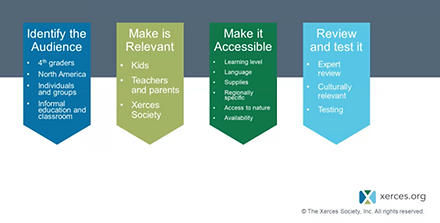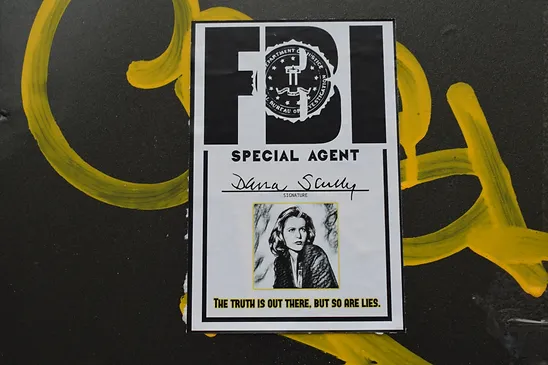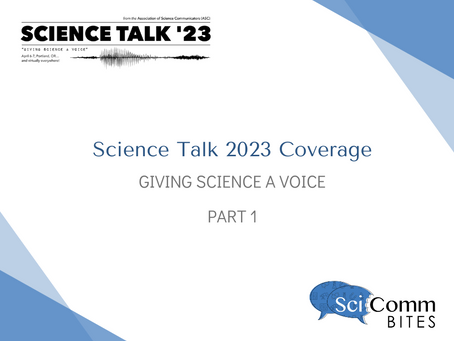Science Talk 2023 Coverage Part 1
By Rebecca Dang
Why I chose to attend Science Talk (SciTalk): SciTalk 2023 consisted of virtual and in-person presentations. The virtual short talks had a range of speakers discussing their science communication work from talk shows to developing grade school science programs. I am interested in learning about different avenues of science communication so attending SciTalk gave me a chance to hear more about the amazing work that others are doing.
Short Talks
X Kids and the Incredible Invertebrates: Inspiring the next generation of scientists
The Xerces butterfly is a bright blue insect, but you might only get a chance to catch a glimpse of one in a museum: this butterfly has been extinct since the 1940s. The devastating extinction of insects and vertebrates is one of the reasons why the Xerces Society for Invertebrate Conservation, a 50-year-old non-profit organization with the mission to conserve and protect vertebrate habitats, was established.
In this presentation, Rachel Dunham, a Community Engagement Coordinator at Xerces discusses the development and implementation of the X Kids program developed by the Xerces Society. This program aims to introduce 3rd to 5th grade school kids to insects and encourage them to explore nature.

The development of the program had 4 main steps.
- Determine the target audience. X Kids was initially developed for Grade 4 students in North America. The Society aimed to make this program accessible for students in large groups, such as summer camps, or participating at home with adult supervision.
- Make the program relevant. The Society ensured that it was relevant to the kids by illustrating characters in the booklet with gender neutral names and providing a badge to kids who complete the program. For the teacher and parents, the program reaches the nationwide science standards in the USA. Once a kid decides to participate in the program, they are part of the organization and its mission to protect vertebrates.
- Make the program accessible to participants. X Kids is available in 2 different languages including English and Spanish. The Society ensured that there was a lot of white space in the activity booklets so that families did not need to purchase additional paper.
- Review the program. The program was reviewed and tested with the LandPaths summer camps. The feedback was used to improve the program before launching it to a larger audience.
To end the session, Rachel shared the lessons learned from developing and launching the X kids program:
1. Identify the audience first so that you can cater the program to your target
2. Bring diverse voices during the development progress and not after you finished
3. Have an actual target audience look, test and review the program
4. Be willing and ready to pivot when you receive feedback
Therefore, the X Kids program is a valuable program for promoting conservation and inspiring a love for nature among young students. The program development provided insightful information for educators as well.
What can SciCommers Learn from Politicians?
Shiva Azma, founder of Fancy Comma, a science communication strategy company, has found a way to combine her 2 passions for science and politics in her freelance work. During the short talk, Shiva talks about various aspects that science communicators can learn from politicians to reach their audience.
First, politicians deliver a clear message to the public. One of the reasons that they can effectively provide an impactful statement during their campaigns is because they directly communicate with people. Whereas scientists may not have a direct communication pathway with their research, policymakers have a simple communication strategy that reflects their audience.
Next, politicians know the message before it is delivered. Scientists have a systemic path when writing a paper: it starts with the abstract, introduction, methods, and conclusion. But the main takeaway is an afterthought, so the main point might get lost in the science writing process.
Third, the way you present yourself matters a lot. People working in Congress are very professional. They dress well and communicate professionally. Scientists need to know that their appearance acts as another mode of communication.
Finally, when politicians communicate to the public, it is not just based on facts. Their speeches involve ideas and emotions. Science has a bigger picture, which can include better living through science, learning more about science, or unlocking the potential of science to treat people. Shiva argues that if scientists frame their speeches to focus more on people instead of facts, then the state of science literacy and public trust in science would improve.
Spicy Science: Fun Science Interviews
Ciencia Picante, translated as Spicy Science, is a talk show on scientific studies and science engagement hosted by science communicator Alessandro Strobbe. The talk show was inspired by late-night talk shows like Hot Ones, where celebrities either answer a question or defer by eating a spicy chicken wing. In this talk, Alessandro discusses how he implements communication strategies in his talk show.
Alessandro shapes interviews with guests by following the Hero’s Journey narrative structure. The hero’s journey structure has been used for centuries and is even used today in movies like Harry Potter. It begins when a hero receives a call to adventure, then receives a supernatural gift or a mentor. The hero then faces challenges leading to growth or new skills that let them overcome a challenge.

In addition to crafting a good story, Alessandro emphasizes that preparation is important to running a talk show. For example, Alessandro learns about the guest(s) by looking up what they do, and getting an understanding of their field beforehand. Also, Alessandro prepares a list of tentative interview questions.
The main structure for the interview is a 50/50 style, where 50% of the questions are personal questions and 50% relate to their research expertise. Alessandro prefers the 50/50 style because it helps the audience connect and see the human side of the interviewee first. Within the questions, there should be a golden question, or the question that gives the interviewee a chance to showcase their expertise. He ends the talk by reminding us that, “Amat victoria curam” which translates to, “Victory likes careful preparation”.
How to Build a Sustainable Career in Science Communication
You might have been introduced to science communication in a workshop, through a podcast, or by reading an article. But can you build a sustainable career doing scicomm? Cassidy Swanston, an outreach content creator at Actua, provides science communicators with insider tips to building your career.
There are 6 main SciComm specializations:
1. Management (Event coordinator, project manager/coordinator)
2. Content (Content developer, program developer, copywriter)
3. External relations (media relations officer, public relation officer, grant writer)
4. Education (visitor experience officer, education designer, education coordinator)
5. Design (Product/graphic/exhibition designer)
6. Marketing (marketing officer/social media coordinator/brand manager)
SciComm specialists can work in various places. Scicomm jobs exist across all sectors including non-profit organizations, public/parapublic, academic and private sectors. When starting your job search, Cassidy recommends connecting and talking with your network in various sectors. Then, make a list of companies that you are interested in working for and keep an eye on when there are positions available. Remember to keep track of your applications so that you do not miss any deadlines.
Science communication jobs might not be labeled as “Science Communication,” so take a close look at the job description. Tailor your application to each position and highlight specific skills related to the job. Enthusiasm goes a long way with communication jobs so show your passion for science while keeping it professional!
Launching a SciComm group: Elevate science communication through guided discussion & training
The Allen Institute is a science research institute focused on research in neuroscience, cell biology and immunology. Because the Allen Institute releases their data for anyone interested in their work, staff members need to be prepared to talk about their research with the general public.
In this talk, Rachel Tompa, a Senior Editor, and Kaitlyn Casimo, the Education & Engagement Manager for the Allen Institute, shared insight on how they created the SciComm@Allen program, which was developed to improve staff members’ scicomm skills. The program was created in 2021 out of staffs’ interest in outreach training. They held virtual sessions over lunchtime on Fridays and structured the program similarly to a journal club with rotating topic leaders. During the first year of the program, Rachel and Kaitlyn offered training sessions that meet people at their skill level and let staff select what sessions to attend based on their interest.
In the second year of the program, Rachel and Kaitlyn plan to offer more specialized training such as training on social media, talking to kids, and talking about animal research. Additionally, they have started a scicomm library with the Diversity, Equity and Inclusion team, and have launched a book club that is starting in Spring 2023.
If you’re interested in starting your own scicomm group, Rachel and Kaitlyn share three tips: 1) get yourself a partner(s) in crime, 2) include hands-on activities, and 3) don’t forget the snacks!
To Shill or not to Shill? Handling the Conflicts of Interest Question
To Shill or not to shill? That is the question Karl Haro von Mogel tackled during his short talk. The term “shill” originated from rigged carnival games: a carnival employee pretending to be a customer would “win” the game, to convince other customers that it is possible to win and encourage them to play.
In academia, though, researchers are expected to disclose their funders and collaborators – so how is shilling still relevant today? Often, shilling is used as a method to shut down discussion online – and the researchers acting as shills might not even realize it! For example, an industry partner working in a controversial science field might prepare some statements for partnering researchers to help them (and the company) avoid debate or controversy online about the research. Even though the researchers can edit these statements and the facts in them may be true, it still feeds into a shilling mindset.

Imagine a picture of the sky. If you only look at the top, you would assume that the photo shows a blue sky. As you see the rest of the image, though, you can see purple. So while it is true that the sky is blue in the photo, it is not the whole picture.
How we frame a topic matters. Even if you’re not being paid to say something, but you are provided with information from your funder, you may put out information without critically thinking about it.
How can you manage your conflict of interest and not be a shill? Karl shared these tips:
1. Disclose any funding and relationships
2. Acknowledge the influence of your conflict of interest
3. Take active steps to manage it by independent checks
4. Seek out diverse and opposing views
5. Be wary of agreeing to partnerships that can harm trust
6. If you make a mistake apologize, correct and do not repeat.
Managing conflicts of interest is crucial to maintaining credibility and trust. By following the tips shared by Karl, you can remain transparent and independent despite potential biases. Disclosing any funding or relationships, acknowledging the influence of a conflict of interest, and owning up to mistakes are all essential steps in avoiding being labeled as a “shill”.
The Cost of Diversity in Stock Photos: A Case Study
People of colour have been talking about the lack of diversity in stock photo libraries for years. The lack of quantified research on diversity on stock photos made it difficult for principal investigators like Michelle Jewell to justify hiring photographers in grant proposals. In this talk, Michelle Jewell and Zachary Chichester, from North Carolina State’s Department of Applied Ecology, shared their research on quantifying diversity in stock images.
In their study, Zachary and Michelle searched five stock photo libraries (Canva, Microsoft Office Image Library, Pixabay, Adobe Stock Images and Getty Images) for images related to preventive health. They took the top 25 images from each photo library. In total, Michelle and Zachary collected a total of 495 images, which they then coded for gender, skin colour (using the Massey-Martin scale), age, and markers of socioeconomic status. They discovered three main findings:
- Light skin was represented more than darker skin colours
- Children and older adults had low representation
- For images that weren’t pregnancy-related, 54% of the stock photos had at least one man and 85% of images had at least one woman, so women were well represented
These findings show that free stock images poorly represent the diversity of communities at risk of preventable diseases – and that it may cost more to develop quality health education resources for underrepresented populations if researchers want to use photos that accurately depict their target audiences. Ultimately, Michelle and Zachary hope that this research will encourage organizations to invest in more equitable photoshoots or illustrations that can be used by everyone, instead of locking diversity behind stock photo library paywalls.
Keynote Speaker: Tamara Krinsky
Tamara Krinsky is an Emmy-winning TV Host/writer/actress and is currently the co-host of the Science Channel series Tomorrow’s World Today. In her keynote talk, she encourages science communicators to “culture the crap out of science communication,” to cultivate a science-positive culture and find the next generation of STEM leaders.
Growing up, Tamara was equally interested in art, science, and theater. While she ultimately decided to pursue theater at Northwestern University, she was still intrigued by science. In 2016, she became the new co-host for the Tomorrow’s World Today series, which focuses on the latest advancement in STEM. Tamara also hosts Marvel Live, where she interviews celebrities and Marvel fans. She emphasizes that both of these avenues – the more traditional science-focused programming, and shows that focus pop-culture – are effective means of engaging people with science.
The entertainment industry has invested a lot of money in marketing to large audiences – and science communicators can use it to our advantage! For example, a 2021 study from the Geena Davis Institute on Gender in Media found that having a STEM role model in pop culture increased girls’ and women’s intentions to pursue STEM in school and as a career. In fact, the character Dana Scully from The X-Files has been cited so often as the reason women pursued STEM careers, that there’s even a name for her influence: The Scully Effect.

Another example that Tamara cites of the impact of culture on scicomm is vibranium. If you have ever seen Black Panther or Captain America, you might know that vibranium is a powerful material that absorbs, stores and releases a large amount of kinetic energy. Vibranium is not real, but audiences often look up the term “vibranium” out of curiosity after seeing the movie. Their search results can lead people to learn about atomic structure or cutting-edge materials like graphene.
In addition to using pop culture as a way to connect with audiences, Tamara encourages science communicators to think about culture in content creation. When designing content, Tamara recommends creators to think about the following questions:
1. Who is the audience?
2. Why are they watching, listening or reading?
3. What language do they speak?
4. What is my role in the story I am telling?
Tamara reminds us to use the culture that people are exposed to and interested in to our advantage. Culture can provide opportunities to invite people into conversations about science, increase engagement, create a positive environment, increase people’s trust in science, and let them feel that science is part of their lives.
Image Credits: Wikimedia, Gal Somovic via Unsplash, Marija Zaric via Unsplash
Edited by: Kay McCallum

